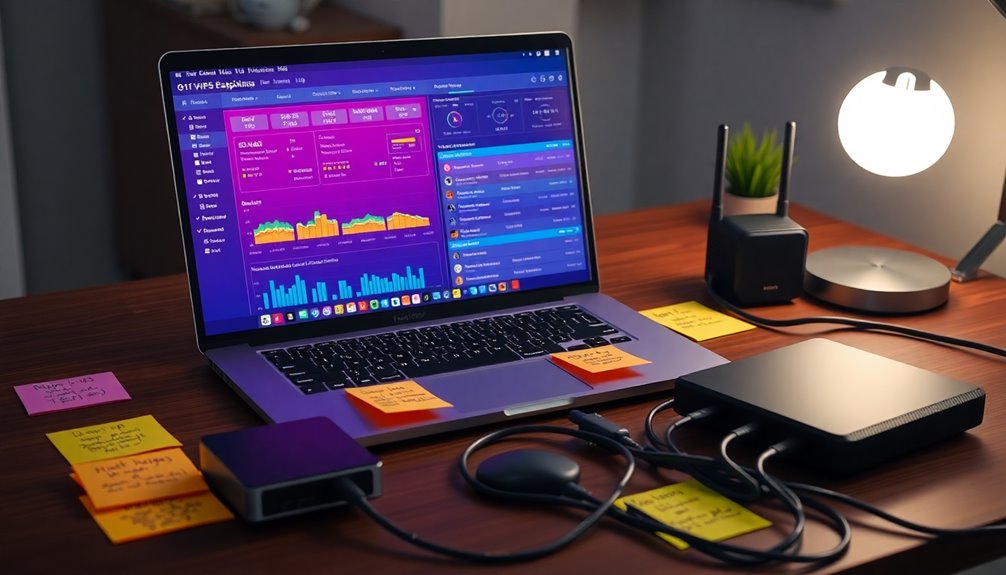To tackle your ultimate VPS hosting checklist, start by grasping the basics of VPS and selecting a reliable provider. Next, set up your VPS with secure access and user privileges. Configure your web stack by choosing a server, database, and caching tools. Don't forget to manage your domain and DNS settings efficiently. Implement strong security measures and perform regular maintenance. As you work through these steps, you'll unlock valuable insights to optimize your VPS even further.
Key Takeaways
- Choose a reliable VPS provider with flexible plans and strong customer support to ensure smooth setup and maintenance.
- Secure your server by changing the default SSH port, generating SSH keys, and configuring a firewall for enhanced protection.
- Install and configure your preferred web server and database, optimizing performance with caching mechanisms and HTTPS implementation.
- Manage your domain and DNS settings by configuring nameservers, A records, and CNAME records to link your domain to the VPS IP.
- Regularly monitor server performance with tools, apply security measures, and perform updates to maintain optimal operation and safeguard against threats.
Understanding VPS Basics

VPS hosting revolutionizes how you manage your online presence by using virtualization technology to create multiple virtual servers on a single physical server. Each virtual server acts as a dedicated environment, ensuring you have guaranteed CPU, RAM, and storage that aren't shared with others.
This isolation enhances security, reducing the risk of breaches affecting your site. You can customize your server configurations and install your preferred operating system, giving you flexibility that shared hosting lacks.
Plus, as your website grows, scaling resources is a breeze. VPS hosting strikes a balance between cost-effectiveness and control, making it an ideal choice for growing businesses or those seeking reliable performance without the expense of dedicated hosting.
Setting Up the VPS

Setting up your VPS is crucial for ensuring a smooth and secure online experience. Start by choosing a reliable provider with excellent customer support and flexible plans. When purchasing a plan, consider the server resources, pricing, and security features.
Most providers offer Linux as the primary OS, known for its cost-effectiveness. Use SSH to access your server, ensuring an encrypted connection for command execution. Remember to manage your initial login credentials carefully, as the root user has high privileges.
For enhanced security, change the default SSH port, generate SSH keys for passwordless login, and set up a firewall. Lastly, create a new user with sudo privileges to minimize risks associated with using the root account.
Configuring the Web Stack

Configuring the web stack is essential for delivering a fast and secure online experience. Start by choosing a web server like Apache, NGINX, or OpenLiteSpeed, and install it using a package manager or control panel.
Optimize performance by adjusting connection limits and timeouts, while ensuring security with HTTPS and firewall settings. For your database, consider MySQL or PostgreSQL, and focus on proper indexing, caching, and regular updates to maintain security.
Implement caching mechanisms with tools like Redis or Memcached to enhance efficiency and speed.
Lastly, set up monitoring tools like Prometheus and Grafana to keep track of your server's performance, allowing you to identify and address potential issues proactively.
Domain and DNS Configuration

After getting your web stack up and running, it's time to focus on domain and DNS configuration. First, purchase a domain from a registrar like Hostinger and manage it using a control panel such as hPanel.
Choose a DNS provider, which can be the same as your registrar or a separate service. Configure your nameservers to point to the VPS if needed, and create a DNS zone for your domain.
Next, set up A records to link your domain and subdomains to your VPS IP address. Use CNAME records for subdomains as necessary.
Don't forget to adjust TTL settings and verify your records with a tool like DNS Checker. Allow up to 24 hours for changes to propagate globally.
Deploying Applications

As you prepare to deploy applications on your VPS, selecting the right tools and environment is crucial for a smooth process.
Start by using Git for version control, which simplifies collaboration. For secure file transfers, consider using SCP or rsync instead of the less secure FTP.
Implement CI/CD pipelines to automate deployments, making your process more efficient. Set up a web server like Apache or NGINX, and choose a suitable database management system like MySQL.
Don't forget to install necessary scripting languages, and consider a control panel like CyberPanel to manage your server easily.
Finally, enhance security by using SSH keys, configuring firewalls, and implementing SSL certificates to protect data transmission. Additionally, ensure your environment promotes natural light to improve the overall workspace ambiance and productivity.
Maintenance and Monitoring

To ensure your VPS runs smoothly, regular maintenance and monitoring are essential. Start by scheduling software updates to keep your operating systems and applications secure and compatible.
Monitor hardware components for potential failures and manage resources like CPU, RAM, and disk usage to optimize performance. Implement automated data backups to protect your information.
Utilize monitoring tools like Prometheus and Grafana to track performance metrics, analyze network traffic, and review access logs for issues. Set up alert systems for immediate notifications on potential problems.
Establish a maintenance schedule with weekly, monthly, and semi-annual tasks, and automate routine jobs using cron. Lastly, maintain detailed documentation of your server configurations and maintenance activities for future reference.
Security Measures

When securing your VPS, it's vital to implement a comprehensive set of security measures right from the start.
Begin with firewall configuration to control network traffic and reduce vulnerabilities. Use Secure File Transfer Protocol (SFTP) for encrypted data transfer and install SSL certificates to protect user information.
Disable root login to enhance security by requiring individual user accounts. Regularly scan for malware to identify threats early.
For access control, adopt SSH key authentication and enforce strong password policies. Limit user access to essential resources and enable two-factor authentication for added security.
Implement intrusion detection systems and activate DDoS protection to safeguard against attacks.
Lastly, create regular backups and encrypt stored data to ensure recovery and protection against unauthorized access.
Performance Optimization

Securing your VPS lays a strong foundation for its performance, and optimizing that performance is the next step.
Start by implementing caching to reduce server load and improve load times. Integrating a Content Delivery Network (CDN) can also distribute content efficiently, further enhancing speed.
Tune your web server settings, like KeepAlive and Gzip Compression, to maximize efficiency. Don't forget about database optimization—creating indexes and cleaning old data can significantly enhance query performance.
Regular updates to your operating system and software ensure they run smoothly. Consider upgrading to SSD storage for faster speeds and better stability.
Finally, use monitoring tools to track resource usage and identify any performance issues before they escalate.
Troubleshooting Common Issues

Troubleshooting common issues on your VPS can be daunting, especially when unexpected problems arise.
Start by verifying your network configuration to ensure it's correct and that firewalls aren't blocking necessary connections.
Next, review your DNS settings, confirming they point to your VPS IP.
For resource overloads, analyze CPU and RAM usage with tools like 'top' and 'htop', and consider upgrading your plan if necessary.
If software installations fail, check your package manager and identify any conflicting packages.
In case of security breaches, reset passwords immediately and review server logs for unauthorized access.
Regularly audit your security measures and implement monitoring to catch issues early, ensuring a smoother VPS experience.
Frequently Asked Questions
Can I Upgrade My VPS Resources Later?
Yes, you can upgrade your VPS resources later. Most providers allow you to increase CPU, memory, or disk space as your needs grow.
Just log into your customer portal, choose the upgrades you want, and power down your VPS for the process.
Keep in mind that this may cause temporary downtime, so it's best to schedule it during low traffic periods.
After the upgrade, monitor performance to ensure everything runs smoothly.
What Are the Differences Between VPS and Shared Hosting?
Did you know that websites on shared hosting can slow down by up to 70% during peak traffic?
When comparing VPS and shared hosting, VPS gives you dedicated resources like RAM and CPU, ensuring stable performance.
You'll also enjoy root access for customization, while shared hosting restricts your control.
If you're expecting growth, VPS makes scaling easier, whereas shared hosting is budget-friendly but may lead to inconsistent performance under stress.
How Do I Transfer My Website to a VPS?
To transfer your website to a VPS, start by assessing your current setup and choosing a suitable VPS provider.
Backup all your data, then configure the new server with the necessary software.
Use tools like FTP or rsync to transfer your files and export/import databases with phpMyAdmin.
Update your configuration files and test everything to ensure functionality.
Finally, update your DNS records to point to the new VPS, and monitor performance post-migration.
What Are the Best Practices for VPS Backups?
When it comes to VPS backups, you should prioritize identifying what data needs backing up and choose between full or incremental backups.
Schedule regular backups to minimize data loss, and consider using automated tools to streamline the process.
It's essential to store backups in multiple secure locations and regularly test your backups to ensure they can be restored.
Lastly, keep your backup software updated to protect against vulnerabilities.
How Can I Monitor Server Uptime and Performance?
Monitoring your server's uptime and performance is like keeping a pulse on a living organism. You can use tools like UptimeRobot for regular checks and Pingdom for performance insights.
Zabbix and Datadog help track real-time metrics, while Monit can automatically fix common issues.
Set up alerts to catch problems as they happen, ensuring your server stays healthy and responsive. Regular monitoring keeps your infrastructure robust and efficient, ultimately enhancing user experience.
Conclusion
In the fast-paced digital world, setting up and maintaining your VPS is like mastering a vintage video game—it's all about strategy and skill. You've covered the essentials from setup to security, ensuring your server runs smoothly and efficiently. By staying proactive with maintenance and optimization, you'll keep your VPS performing at its best. Remember, a well-tended server not only boosts your site's reliability but also enhances your online presence. Now, go level up your hosting game!









